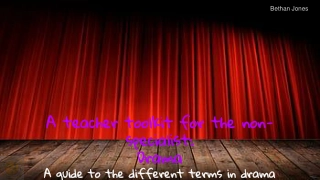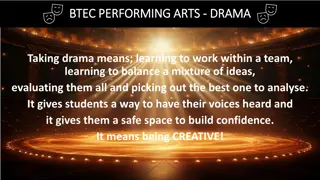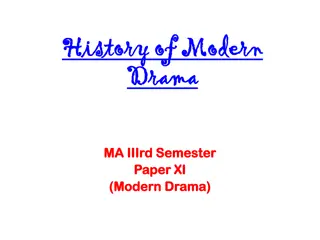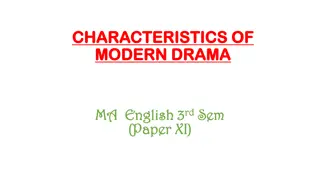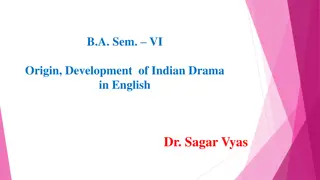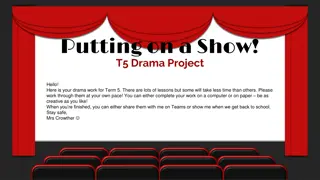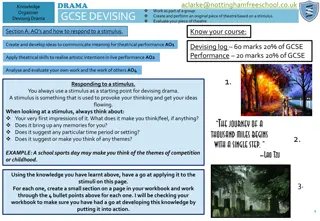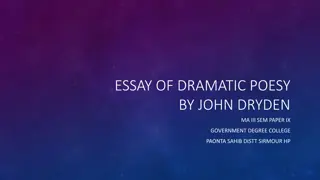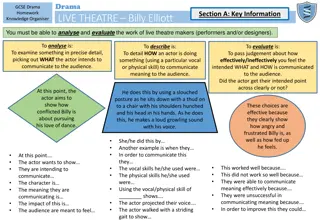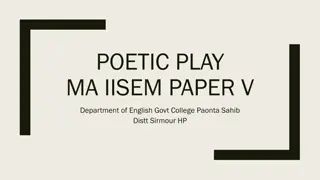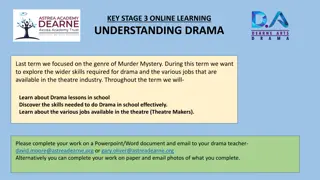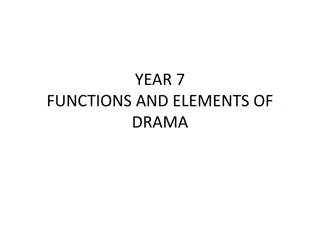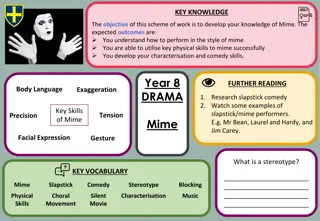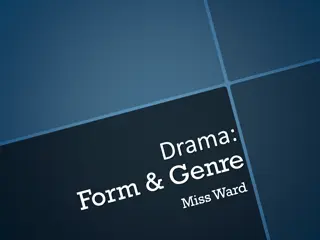
Evolution of American Drama: From Rituals to Realities
Explore the evolution of American drama from ancient ritualistic performances to the modern-day theatrical landscape. Tracing a historical overview, the influence of key playwrights like Eugene O'Neill is highlighted, reflecting personal tragedies and societal shifts that shaped the American theatrical experience. Discover the journey from the Middle Ages to the 20th century, witnessing the development of a distinctive American dramatic tradition rooted in cultural nuances and societal transformations.
Uploaded on | 0 Views
Download Presentation

Please find below an Image/Link to download the presentation.
The content on the website is provided AS IS for your information and personal use only. It may not be sold, licensed, or shared on other websites without obtaining consent from the author. If you encounter any issues during the download, it is possible that the publisher has removed the file from their server.
You are allowed to download the files provided on this website for personal or commercial use, subject to the condition that they are used lawfully. All files are the property of their respective owners.
The content on the website is provided AS IS for your information and personal use only. It may not be sold, licensed, or shared on other websites without obtaining consent from the author.
E N D
Presentation Transcript
AMERICAN DRAMA AMERICAN DRAMA
Genre difference: presence Ritual? To what extent is this a power? Creating a community through a common spiritual experience. ANCIENT DRAMA-ELEMENTS DIALOGUE CONFLICT PERIPETEIA: turn of fate, irreversible ANAGNORISIS: recognition, awarness TRAGEDY: conflict within the individual (public and private) CATHARSIS: Medical term, cleansing, The aesthetic experience of fear and pity (ARISTOTLE: POETICS)
BRIEF HISTORICAL OVERVIEW MIDDLE AGES: 1. Connected to the sacred: mystery plays, miracle plays, morality plays (street-stage) 2. Connected to the profane: fablieaux (The two often together!) RENAISSANCE: audience is close, entertainment and spiritual experience still together PURITANISM: closing of theatres (spiritual experience outside of the church: dangerous!) 18th CENTURY: gap created between players and audience (curtain, orchestra pit), entertainment for the well-to do civilians LATE 19th CENTURY: Ibsen, Chekhov, Strindberg: domestic plays, drama on a small scale, in the family, gap between reality and illusion, insoluble problems, wasted lives, life- lies IMPACT on the development of the American Drama
AMERICAN DRAMA AMERICAN DRAMA No serious theatre until the 20th century Reasons: 1. Puritans 2. Moving society : no time/need for established theatres 3. When the need came: mainly for entertainment business 4. Facing one's problems: not pleasant, uncanny experience 5. Movie industry came up parallelly: the American Experience seemed to be more fit for the screen 6. American dream/ American nightmare: Edward Albee: THE AMERICAN DREAM (one-act play, a young man in a suit, empty character) 1910s: "Little theatre" movement: at universities, (eg: Provincetown Players), but: Long way to success: off-off Broadway, off-Broadway, Broadway, Hollywood
Eugene ONeill Irish background: burden and bliss Personal tragedies reflected in his plays Father: a popular actor, Eugene grew up in the theater, was aware of its possibilities 1936: Nobel Prize 1888-1953 First edition 1933
A revenge on theater, too long, too many impossible stage directions Autobiographic: could not be performed in O Neill s lifetime The play: a single day in August 1912 The setting is the seaside Connecticut home of the Tyrones, Monte Cristo Cottage Four main characters are semi-autobiographical representations of O'Neill himself, his older brother, and their parents. Theme: a family struggling to grapple with the realities and consequences of the failings of other family members in relation to their own. Accusations of blame, resentment, bitterness and jealousy The story deals with the mother's psychosis due to an addiction to morphine, the father's miserliness and sense of deep regret, the older brother's licentiousness and younger brother's bleak optimism through illness (consumption/tubercolosis). Adult children cannot grow up Special choreography : the rhythm of offense and apology loving one another can also be a burden Significance of the fog: means of escape? Staying together? Literature & Art: can it be helpful in a family crisis? First edition 1956
ARTHUR MILLER (1915-2005)
Born: Manhattan, son of Polish-Jewish immigrants Raised in Brooklyn NY public schools graduation (Depression) Work: for his tuition fee, University of Michigan Still in college: plays university awards BA: 1938: New York Federal Theater Project 1938-1947: Radio plays for CBS&NBC, screenplays, articles, stories, a novel 1944: His first play ( The Man who had all the Luck) No success, but: guilt&moral responsibility , themes of later plays PRIZES: Hopewood Award, Bureau of New Plays Prize, Theatre Guild National Prize 1956-1961: Married Marilyn Monroe (she converted to Judaism) Poster for the 2002 Broadway revival
Ethics &morality (cf. E. E. Cummings: [a salesman is an it that stinks] Values of American business practices fatal consequences Illusions of an ordinary man Willy Loman ( low man ), the average good-willing American, a victim of his own ideals: crushed by the American dream Present and past scenes: separated on the stage Hungarian National Theatre, 1959. Directed by Endre Marton, Willy was rendered by J zsef T m r. First edition cover (Viking Press) 1947
1953 Set in the 17th century New England A modern play: anticommunist witch hunt Committee of Un-American Activities questioned him Senator Joseph McCarthy Hysterical domestic climate Investigating soviet spying&subversion Summoning, questioning suspected individuals, blacklists, etc... Miller denied a passport in 1954 1956: Was summoned: refused to name others Citation for contempt by a federal grand jury 1958: the conviction reversed
NATURE OF MODERN TRAGEDY TRAGEDY and THE COMMON MAN (1949) After the opening of Death of a Salesman No heroes, no belief, skepticism of science We are below tragedy Tragic mode: archaic- fit only for the very highly placed BUT: Oedipus & Orestes complexes apply to everyone The tragic feeling is evoked when we are in the prescence of a character who is ready to lay down his life, if need be, to secure one thing - his personal dignity, wound of indignity Tragedy: the consequence of man's total compulsion to evaluate himself justly Tragic flaw: not remaining passive in the face of a challenge to one's dignity, his image of his rightful status Total examination of the "unchallangable" environment Terror & Fear: classically associated with tragedy Tragedy enlightens: points a heroic finger at the enemy of one's freedom The tragic stature: for a moment everything is in suspension, nothing is accepted and in this stretching apart of the cosmos, in the very action of so doing, the character gains "size" "I believe that the common man is as apt a subject for tragedy in its highest sense as kings were."
The commonest of man may take on that stature Willingness to throw all he has into the contest Battle to secure his rightful state in his world Misconception of tragedy: the idea that tragedy is of necessity allied to pessimism Claim: in truth, tragedy implies more optimism in its author than does comedy Its final result ought to be the onlooker's brightest opinions of the human animal Indestructable will of man to achieve his humanity Possibility of victory must be there Belief in human perfectibility, the heart and spirit of the average human being
Tennessee Williams 1911-1983
Illusion vs. Reality Destroyed individuals, but not essentially due to a social drama Poetic characterization Common men exceptional women Hopeless struggle, (feminine), illusion, self-delusion Background: rather Checkhov (originally: comedy-writer) VALUE (symbolic) SENSITIVITY, delicate HARSH REALITY HARSH COLOURS, LIGHTS COMMONNESS
BIOGRAPHY Born: Columbus, Mississipi English, Welsh, and Huguenot ancestry Mother: daughter of an Episcopal Reverend, living in the Episcopalian Rectory Father: a traveling shoe salesman, alcoholic, brutal His sister: Rose Isabel Williams- oversensitive , lobotomy, aslyums South: not exactly Faulknerian, it is more of a symbolic decoration for him His instable health : got fired from factory work-contract 1938: BA at the University of Iowa First plays: one-act pieces
1944, reputation came along Characters: Amanda, Laura, Tom They have larger, stronger feelings than what they can contain Realistic elements but not realistic theatre Symbols, sentimental beauty "himself" portrayed all the time Lost, self-punishing individuals Alienated sympathy Sexual frustration (himself: homosexual), theme of perversion
1947 Hypersensitive heroine: spirituality- unable to face harsh, vulgar reality Southern setting: word of illusion, old, outdated value-system- corruption (Blanche Dubois) vs. Immigrant American values (Stanley Kowalski) Theatrical release poster by Bill Gold
CONFLICTS SOUTH-IMMIGRANTS: the importance of tradition (Blanche) vs. being a "Polack" with the pride of being 100%American (Stanley) BLANCHE-STELLA: Sisters with the same background. Stella left earlier, turning her back on the family, following her new dreams. Does love prevent one from all identity-problems? Blanche: staying there to bury the family members love and marriage: painful story (husband's homosexuality and suicide), failure STELLA-STANLEY : Harmony- living for the future(colored light bulbs) But: Stella can only remain in this harmony if she ignores Blanche's story about the rape, taking it as a proof of her sister's madness BLANCHE-STANLEY: Tension from the start. Blanche takes him to be primitive, raw, physical (this also attracts her to some extent) Stanley takes her to be pretentious, oversensitive and finicky (although attractive). Reminiscences of a tense teacher-student relationship, Stanley wanting to prove his erudition and expertise. Meddling with her suitcase: foreshadowing the rape scene, intruding into her privacy. Overheard conversation: Stanley deeply hurt by the ape-simile. Ticket as a birthday present: Blanche deeply hurt. Rape: complete frustration.
BLANCHE-MITCH : Last hope for Blanche ( "Sometimes- there's Godso quickly). Mitch: the kindest hearted of the male company, chivalrous to some extent. Blanche: trying to adjust her sense of courtship to the circumstances. Mitch: believing her stories, but then also believing Stanley's information. " You are not clean enough to bring in the house with my mother"- Blanche screaming: "Fire!" SOLUTION: Distrurbing- the situation cannot be tolerated any more- Blanche is sent to a mental hospital. I have always depended on the kindness of strangers Stella: ambivalent "What have I done to my sister? " Ending: Stanley's soothing words- end of the poker game.
OTHER POSSIBLE ASPECTS of ANALYSIS AND COMPARISON LIGHT RAW REALITY PRESENT MALE SANITY VULGAR VIOLENCE SILENCE DIM REFINED ILLUSION PAST FEMALE MADNESS LITERARY SENSITIVITY MUSIC The legendary rendering of Blanche Dubois for more than 20 years, Eszenyi Enik , V g Theater, Budapest
First Hungarian Blanche, Tolnay Kl ri, directed by V mos L szl , 1962 Vivien Leigh in the trailer for A Streetcar Named Desire Marlon Brando as Stanley Kowalski (1948) directed by Elia Kazan
Edward Albee (1928-2016)
Born: Washington , D. C. Adopted as an infant by Reed A. Albee and Frances Cotter (businessman and a socialite) Was named after his adopted grandfather (part owner of a chain of vaudeville theatres) Westchester County, New York: prosperous life, entertainers, celebrities Private boarding&military schools: Trinity College, Hartford, Connecticut No degree Settled in Greenwich village: odd jobs for a decade First succesful play: Zoo Story: short, two-character play, failure of communication violence 1960: Off-Broadway, New York production Harry Houdini and Jennie, the Vanishing Elephant, vaudeviulle stage
1962: WHO'S AFRAID OF VIRGINIA WOLF 1966: Film version (Richard Burton, Liz Taylor) Tony Award for best play Theatre of the absurd (Martin Esslin) Experiments 60s, 70s Late night party, two childless marriages, academic background Old couple: more vitality Games: torturing each other and the guests, humiliation abusive, toxic relationships? Possible wolves : ageing, losing a sense of humor, no future, empty life Martha and George: first names are the same as that of the 1st president of the US, George Washington and his wife, Martha Broadway premier poster
"What a dump!" Theatre of embarrassment Title: seen on the mirror in a public restroom Who s afraid of the big bad wolf? a popular song which originally featured in the 1933 Disney cartoon Three little pigs Virginia Woolf? Literature as such? Quotations illusion reality Beyond the forest (1949) Bette Davis
GAMES THREE ACTS 1. "Humiliate the Host" 2. "Hump the Hostess" 3. "Get the Guests" 4. Bringing up Baby 1. FUN AND GAMES 2. WALPURGISNACHT 3. EXORCISM POSSIBLE PARTNERS YOUNG COUPLE WOMEN NICK HONEY NICK OLD COUPLE vs. MEN vs. GEORGE vs. MARTHA vs. MARTHAvs.
Absurdity language reality Illusion? Trap! George and Martha: professionals? Do they love each other? Game: against hypocrisy, conformity, brutal What is broken? Vulnerability? Academic perspectives: quicksand? Are they determined by history? Or by biology? Imaginary child killed in the end: hope for a normal life? Or loss of all hope?

